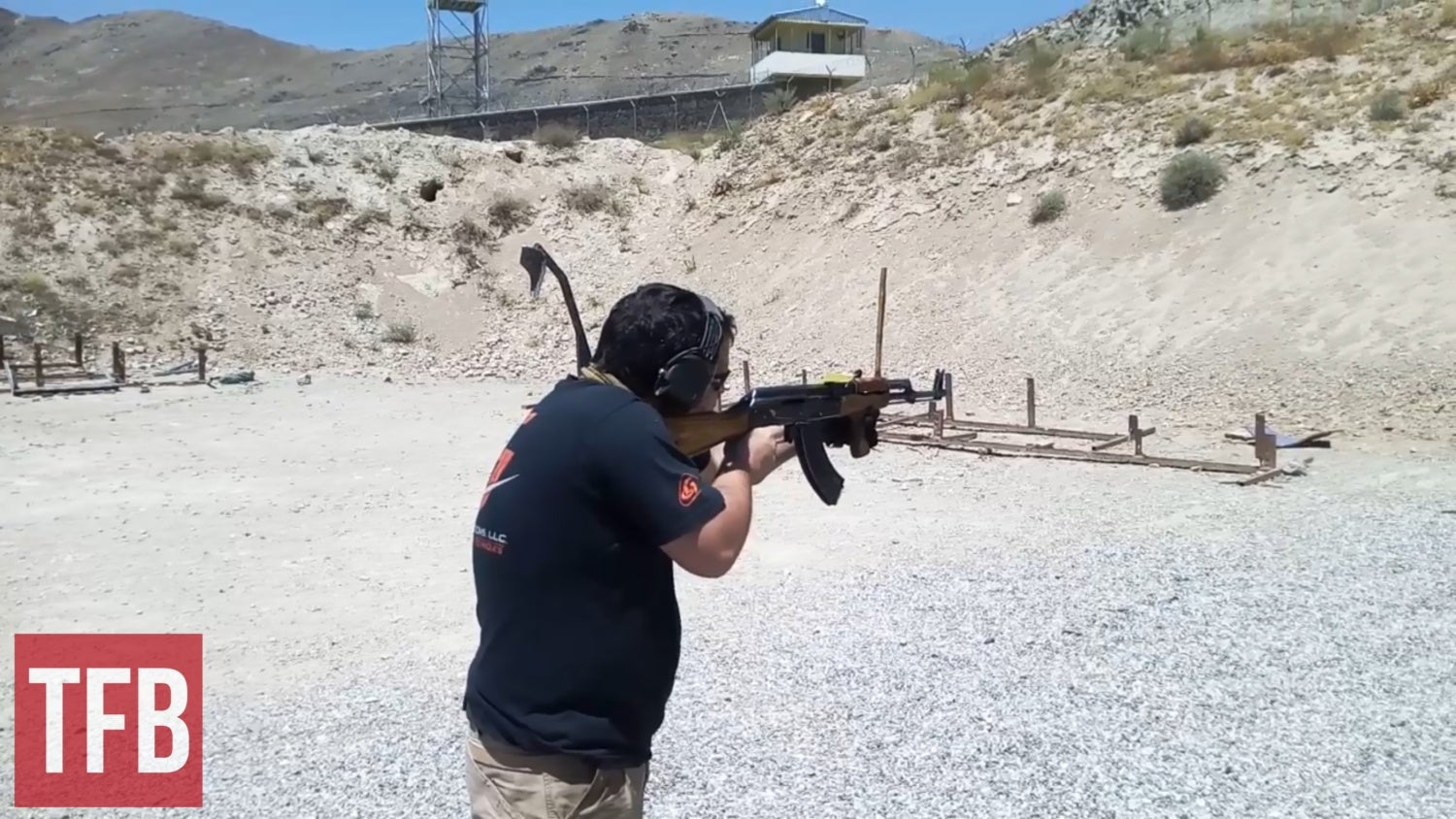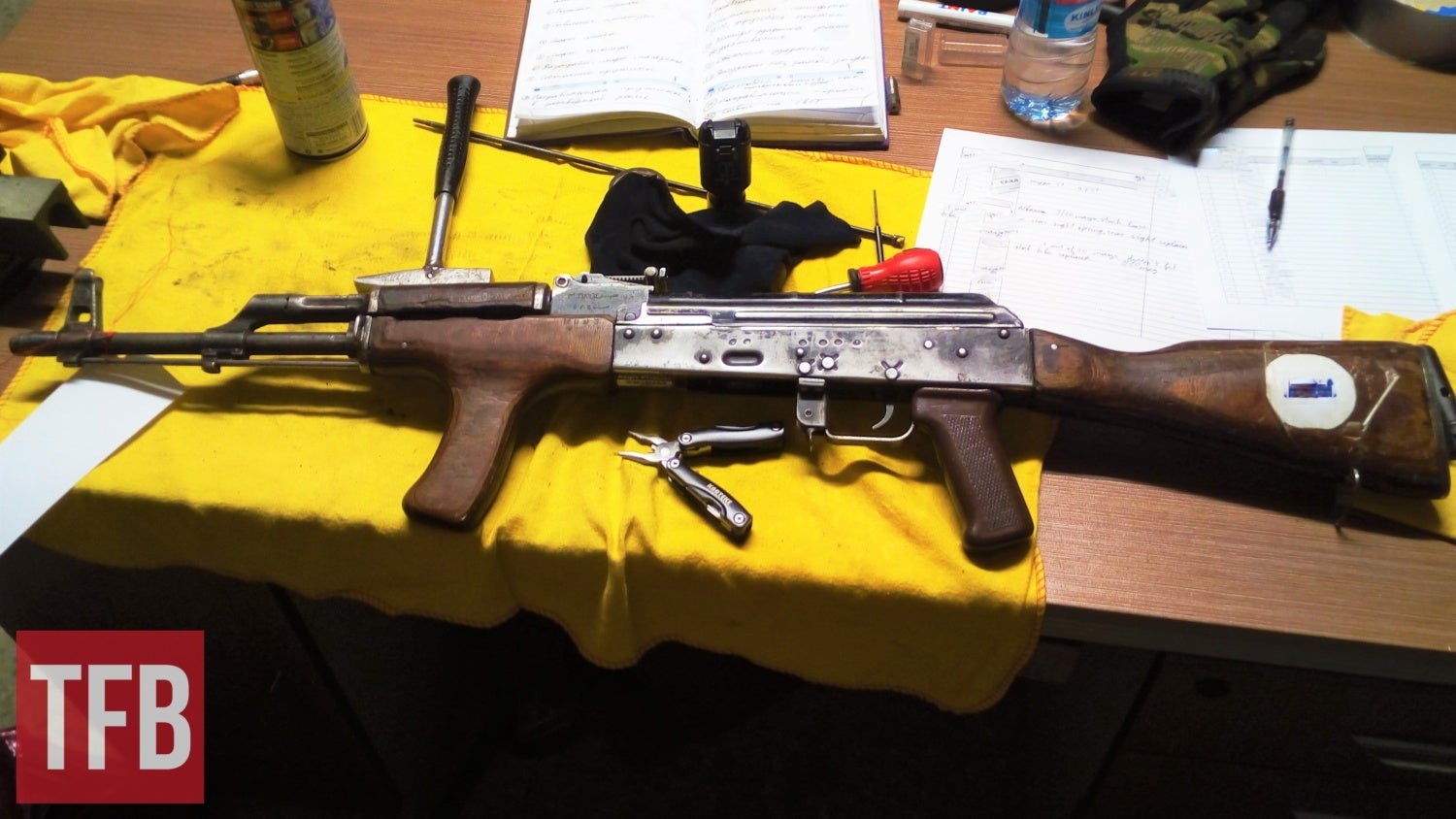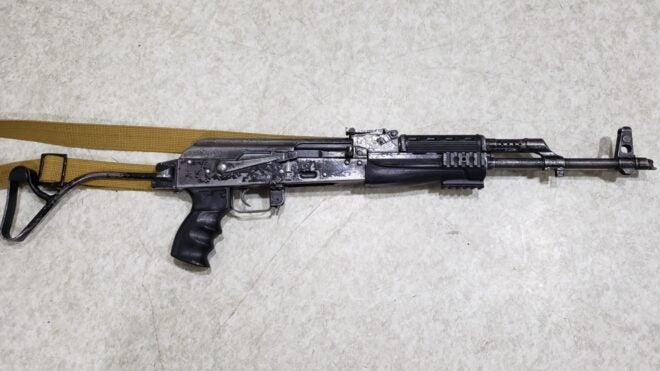Many people in Africa, the Middle East, and the US would have a hard time finding Romania on the map. But there are at least two products originating from Romania that have worldwide acclaim – the stories about Count Dracula from Transilvania and Romanian AKs.
AK History @ TFB:
- The AKS-74U Krinkov Short Barrel AK History & Review
- The Unknown History of Russian AK-12 Kalashnikov Rifle: Part 2
- History and Evolution of Soviet/Russian AK Muzzle Devices
- The Unknown History of Russian AK-12 Kalashnikov Rifle: Part 1
Whenever you go to a war zone in Africa or the Middle East, you’ll see plenty of Romanian AKs in the hands of rebels, police officers, soldiers, and villagers protecting their cattle and livestock. In my travels across those places, I inspected and repaired hundreds, if not thousands of those AKs and learned to respect them, but at the same time, not overlook some of the drawbacks they have.

Author, shooting AIM md 63 on the range near Kabul
Why Romian AKs are so popular? The answer lies in the modern Romanian history. After World War II, it became one of many Eastern European states that fell under the Soviet Union’s sphere of influence. But unlike other countries within the Warsaw Pact, Romania retained a lot of independence and wasn’t afraid to argue with new communist overlords.
The Romanian army did not participate in Warsaw Pact joint military exercises, and Soviet troops withdrew from Romanian territory. There was one more neat feature of this policy. Romania’s defense export remained completely independent and served the country’s interest and not the political agenda of the international communist movement.
As a result, throughout the 60s, 70s, and 80s, Romania was in the top ten defense exporters in the world, selling everything from tanks to rifle ammunition all over the planet. In 1976, Romania transferred its AK manufacturing technology to Egypt. To this day, cruising around Egypt, you can easily find a lot of guns with wooden grips on handguards with some Romanian markings.

Egyptian AK, a nearly exact copy of AIM md 63
Production of the Romanian AKs started the same way it did in other Eastern European countries, with the transfer of technology from the Soviet Union. However, the transfer to Romania happened later compared to other countries, so unlike Poland, Hungary, East Germany, China, Bulgaria, and North Korea, Romania never exported milled receiver AKs.
The first AK mass-produced in Romania was called Pistol Mitraliera md 63, with the export version having a different name – AIM. At first, it was an exact copy of the Soviet AKM, but after a couple of years, it received a very distinctive feature – an awkward-looking wooden grip on the lower handguard. The exact thinking behind this design is unknown, however, one source claims that it was a direct order from Nicolae Ceausescu, the dictator who ruled Romania from 1965 to 1989.

MD 63 AIM. Photo by Rob Stott, taken from the AK47 catalog book series http://ak47catalog.com/
Allegedly, when he just came to power in 1965, he visited the rifle factory and checked out Romanian AK fresh off the assembly line. After a quick inspection, Ceausescu said: “As a seasoned guerilla fighter, I think you should add the grip on the handguard for better control of the recoil”. In any totalitarian society, the word of the supreme leader is the law for his humble servants.
Ironically, 34 years later, Ceausescu was executed with this exact type of AK. According to Ceausescu’s executioner, military officer Ionel Boieru, here is how it went down: “I fired the first shots – three bursts of my AK-47. During the first burst, I saw Ceausescu fall on his knees and topple backward. The first bullets went into his legs and as the gun went up they went into the upper part of his body. So apparently, Ceausescu was wrong after all, the front grip on a handguard didn’t help with minimizing muzzle climb. And I guess he learned his mistake in the hardest way possible.

Ionel Boieru, a Romanian officer who executed Ceausescu in a documentary depicting the trial
Just like the Soviets, Romanian factories produced AKs with underfolding stocks designated Pistol Mitraliera model 1965. An export version of this gun is known as AIMS. The signature handguard with the forward grip didn’t work with a folding stock, so for this version of the gun, the factory developed an even more awkward handguard with the grip angled back. This grip got in the way during reloads when you rock in the mag.
The folding stock was also a bit unique, but not in a good way. Over the years, I repaired plenty of underfolding stocks, but Romanian stocks were among the worst. The actual folding buttplate would break and fold forward instead of backward. And since the buttplate is riveted to the stock, there is nothing you can do in the field to fix it. One of the most annoying folding stock issues I’ve experienced.

Broken stocks on Romanian AIMS md 65
There was also another version of both md 63 and md 65 for the Romanian paramilitary force called Patriot Guards (Gărzile Patriotice). This organization was created after the 1968 invasion of Czechoslovakia when the Soviets and Warshaw Pact attacked one of their socialist allies that dared to deviate from the communist party line. Ceausescu realized, that pledging his allegiance to communism does not guarantee that one day he won’t be invaded by Warshaw Pact.
To stop such an invasion, he created Patriot Guards. But apparently, those guards weren’t deemed patriotic enough to be trusted with fully automatic weapons. They were issued a specific type of rifle often called Romy G that was semi-automatic only. In case of a full-scale invasion, the trigger mechanism of those rifles could be replaced with a full auto trigger group.

Romy G. Photo by Rob Stott, taken from the AK47 catalog book series http://ak47catalog.com/
Patriot Guards rifles were marked with a letter G on the rear sight block and some black paint on the stock. Those guns were never used to repel foreign invasion and a lot of them ended up in the US as parts kits.
In Part 2 of this article, I will continue the story about Romanian AK variants and some of its most unexpected users. And if you have anything to add to the story of Romanian AK, please let me know in the comments.
P.S. The author would like to thank Rob Stott for his photographs. Check out his website and series of books http://ak47catalog.com/
I’d also want to thank members of https://www.theakforum.net/ for collecting a wealth of information about Romanian AKs over the years.
 Your Privacy Choices
Your Privacy Choices
